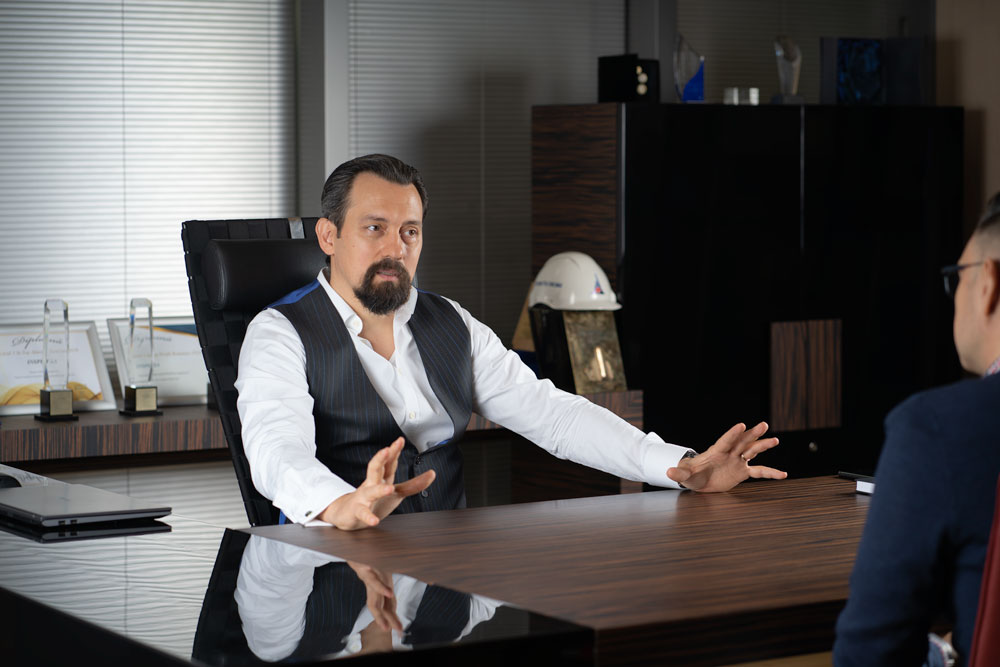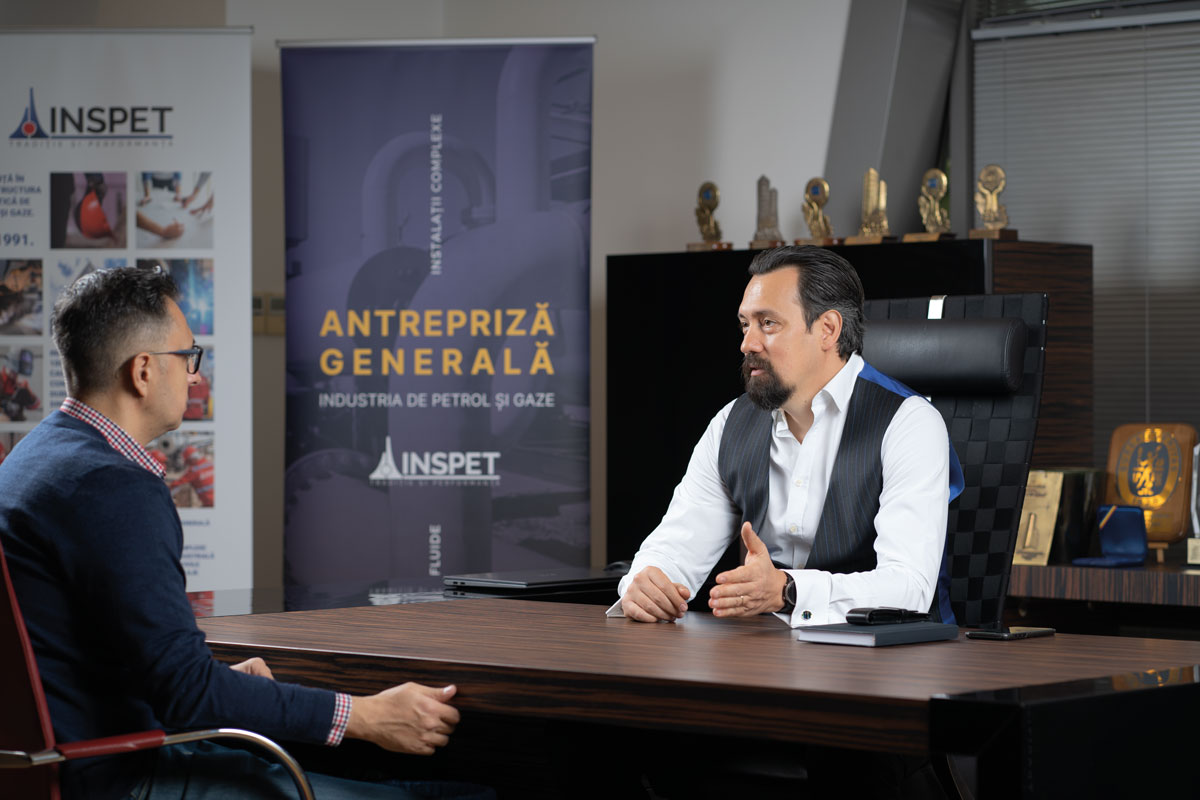Ciprian Păltineanu on INSPET’s Vision and Prospects for the Future
In 2021, INSPET marks 30 years of excellence in oil & natural gas infrastructure. We used the occasion to talk to Ciprian Păltineanu, CEO and Chairman of the Board, about company’s major projects and prospects for the next years.
Established in 1991, INSPET is the largest company with private Romanian ownership, active in the construction-assembly and general contracting for the oil and gas infrastructure. The most relevant projects completed as general contractor and constructor include the execution of the three gas compressor stations (STC Podișor, STC Bibești and STC Jupa) as well as Lot 1 (the first 180 km) of pipeline within BRUA – Phase I project, undercrossing of Prut River and Iași-Ungheni gas pipeline, part of interconnection of the Romanian and Moldovan gas transmission systems, undercrossing of the Danube River with two gas pipelines, in Giurgiu-Ruse area, part of interconnection of the Romanian and Bulgarian gas transmission systems, gas compressor and dehydration station at Sărmășel underground storage facility, upgrade of STC Șinca and STC Urziceni, Ghercești gas storage facility, various technological facilities of Bilciurești gas storage facility and upgrade of Petrotel-Lukoil refinery.
Ciprian E. Păltineanu, MBA, is the CEO & Chairman of the Board of INSPET SA, the leading Romanian general contractor for energy infrastructure (main pipelines and complex installations in oil & gas), a 30-year-old company that is contributing to EU’s climate neutrality objectives.
Manager, finance expert and investor with 20+ years of experience in energy, advisory, corporate & investment banking, investment management and private equity in Romania, Austria, the CEE, Great Britain, and the United States, Ciprian focuses on advancing the principles of a greener Europe while increasing competitiveness and productivity of the domestic industrial ecosystem.
Ciprian Păltineanu is non-executive director or advisor of several Romanian and British companies, member in the Board of Directors of CCIPH (Chamber of Commerce and Industry Prahova), member of the Board of Directors of RoFin.Tech (Romanian FinTech Association), as well as a member of ASPES (Association for Social-Economic Studies) and TechAngels Romania (Association of Romanian Business Angels).
A graduate of UniFuture program at IMD in Lausanne, Ciprian has an MBA from Tulane University in New Orleans and a BA in International Business from the Academy of Economic Studies in Bucharest.
Dear Mr. Păltineanu, with more than 20 years of professional experience in energy in Romania and abroad, how do you evaluate the Romanian energy market compared to other European/global markets of the same type? What is INSPET’s position in this landscape?
Ciprian Păltineanu: There are several industries where Romania has a tangible potential to outperform its European peers, even the larger and more developed countries; energy is clearly one of these industries. Natural gas and renewables are driving the growth of the Romanian energy sector, alongside innovative nuclear and hydrogen potential.
Natural gas – a low-cost, commercially-viable transition fuel with a proven beneficial impact as the least carbon-intensive fossil fuel – is and will remain an integral part of the global energy system during its path to climate neutrality.
There are various reasons to expect an increased demand for natural gas, both in absolute terms and as percentage of the energy consumption mix: the gradual phasing out of coal power generation capacities, increased demand for blue hydrogen from natural gas, development of other higher-value utilization and conversion facilities as well as – critical for Romania – ensuring access of the entire population to natural gas distribution networks.
The natural gas transport infrastructure outranks the electrical grid, with lower costs and increased efficiency (for the same level of capex, a gas pipeline can transport 10-20 time more energy than an electricity cable), lower environmental concerns, shorter duration for planning, permitting and construction. Natural gas power assets are also critical for balancing the national energy system. Therefore, without denying the need of additional investment in much needed high-voltage electrical power lines as well as continued investment in renewables, natural gas is undoubtedly a strategic priority for Europe and specifically for Romania.
Romania is currently the second largest producer of natural gas in the EU and fourth in Europe, but the domestic production is not enough to cover consumption. More discoveries and subsequent gas field developments – both on- and offshore – as well as underground storage facilities are strongly required in order to secure the supply side.
The opportunity is now, considering the significant lead time for such large, strategic projects; delaying investment decisions and execution will expand the imbalance and limit the positive impact of energy sector in Romania’s GDP.
INSPET belongs to a peculiar type of companies, specifically the Romanian privately-owned contractors and constructors of energy infrastructure. As such, being for better or worse tributary to a seven-decade history, via its predecessors and by itself, INSPET shares many of the strengths and weaknesses of that sub-sector. For once, we have capitalized on our long tradition of excellence in education and professional projects in the energy field not only in the region, but also in Middle East and Africa, allowing us to successfully execute over two billion dollars’ worth of projects in the past 30 years. We have never had a performance bond executed, in spite of increasingly complex projects and client expectations for tight deadlines and frugal budgets. On the other hand, we are predominantly, although not entirely, relying on oil & gas projects; the trend of decarbonation might impact the capex plans of our traditional clients and therefore our top line. Moreover, the free EU labour market coupled with the historical underinvestment in professional education in Romania, has made increasingly difficult for us to recruit and retain qualified talent. Last but not least, in public acquisitions, we are sometimes facing competition from companies that spread thin and place bids below their actual real costs, ultimately failing to perform on time, jeopardizing the execution of public projects or by unexperienced new entrants that “lease” qualifications from foreign companies that will never actually do any works.
Nonetheless, for 30 years now, INSPET is still synonymous to a tradition of performance in executing energy infrastructure projects. We are the domestic company that built pipelines twice the distance between Ploiești and Brussels, we are highly reliable partners to our clients, never letting them down irrespective of the complexity of the works; in our sub-sector, we are among the few companies strategically positioned to embark on, finance and execute the large natural gas projects critical for the Romanian economy.
Besides natural gas, we are increasingly focused on hydrogen, researching its impact on various pipeline materials and components, at various pressure conditions, to have tangible data and develop feasible solutions for storage and transport of pure H2 or methane-hydrogen blend.
INSPET operates in a very specialized industry, carrying out works that often withstand the most unfavourable weather conditions, internal pressures of dozens of atmospheres, toxic or corrosive substances, within the highest quality human and technical standards are pursued. What are some noteworthy activities and relevant projects of INSPET? Who are INSPET’s main partners and clients in Romania and abroad?
Ciprian Păltineanu: In the past 30 years we have successfully completed over 200 projects including 4,000 km of pipelines for transport of crude oil, petrochemical products and natural gas, distribution of natural gas and water, over 20 crude oil pumping stations, over 40 natural gas compressor stations, dehydration plants and underground gas storage, representing over 10 million inches of weld and over 60 million work hours.
Due to the specifics of the core business, INSPET’s main clients are strategic companies in the Romanian oil and natural gas industry: state-owned and privately managed companies and multinational majority-owned companies. For optimal use of its capacity, INSPET also executes construction and assembly projects for non-energy industry beneficiaries: manufacturing companies, real estate companies, local councils, ministries etc.
We are proud of all our projects, yet the most noteworthy are the projects (some carried out in association with other Romanian or foreign companies) of strategic importance for the security of the National Energy System, some representing true premieres at a national or regional level.
Among the most recent ones are the execution of Lot 1 (km0 – km180), the three gas compressor stations (STC Podișor, STC Bibești and STC Jupa), as general contractor in two consortia of local companies, as well as several sections of Lot 2 (31km of transit pipelines) DN800 PN63 bar, as constructor, within the BRUA project, with Transgaz as the beneficiary. BRUA is the largest investment project to date of the national natural gas industry, which allowed to increase Romania’s export capacity to Hungary by up to 1.75 billion cubic meters per year and to Bulgaria by up to 1.50 billion cubic meters per year, as well as complying with the application of the European regulatory framework for the reservation of natural gas transmission capacity.
INSPET is currently commissioning the two twin natural gas compression stations in Onești and Gherăești, including the pipeline automation and security for the development of the National Transport System in North-East Romania and towards the Republic of Moldova, for Transgaz, as general contractor in a consortium of companies, the TEG natural gas dehydration unit at Bilciurești, for Depogaz, as well as other very interesting (and sometimes challenging) projects for private companies.
The successful execution of such landmark projects prove that we are not just building infrastructure. Every day, we build Trust!
The energy transition cannot take place in an instant and we are aware that we will not be able to stop using fossil fuel completely. So, we consider gas as a transitional energy carrier. What do you think the biggest challenges facing the energy sector and infrastructure in Romania are?
Ciprian Păltineanu: Realistically speaking, we cannot just stop using fossil fuels, all of a sudden. Actually, for obvious reasons, not even the most ambitious plans of the rational players do not forecast a near future with energy solely from fully renewable sources. In spite of a steady decline, the capex costs of renewable technologies remain high, in some cases (hydrogen) even the opex are excessive, the technology is highly dependent on manufacturing in countries not fully observant of best environmental and procurement practices, and output varies with the wind, sunshine or water level, requiring proper balancing, not to mention the environmental concerns of hydro and especially nuclear power. Besides the uncertainty in securing the supply, the high total costs of producing renewable energy – ultimately transferred to the consumer – are having an adverse short-term impact on economic growth and the widespread adoption.
Let us not forget that the European Green Deal is a balancing act between climate action via decarbonation on one side and growing EU economy and expanding its competitiveness!
Therefore, accelerating the “transition to green” needs to take into account the current cost of renewable technology, cost of carbon and the need for a sustainable energy mix, to consider all medium to long term impact and to be gradual, without negative shocks to economic development.
Thanks to its lower carbon footprint and strategic role in the energy mix, as stated by the IEA, natural gas is one of the mainstays of global energy.
Gas is not a competitor, but an enabler of volatile renewable capacity. Romania has a slight advance in terms of the share of renewable energy compared to the European Union average, yet it is one of the EU countries the most dependent on coal for high-cost electricity generation. To achieve optimal transitional impact from the use of “variable” renewables, the following challenges related to the energy infrastructure and market would need to be addressed:
Limited natural gas production. As Romania plans to add more renewables capacity, while phasing out coal, it requires increasing quantities of natural gas that – at least for the moment, in spite of our top EU position as reserves and production – cannot be provided from domestic extraction.
No national smart grids. Integrated gas-based grids are essential when renewables are less effective due to sub-optimal weather condition, as recently witnessed in UK or Southern US. Energy actors should find a fair mechanism to share the costs for the gas-based infrastructure, considering its balancing role.
Electric grid as a bottleneck. Investments in rehabilitating and expanding the electric grid are needed in areas with insufficient transport capacity.
No legal framework for Power Purchase Agreements outside the centralized market. Last year PPAs on the centralized market were allowed; a functional market would allow OTC agreements.
Bureaucracy for connecting renewables to the grid. Process needs to be simplified; time is of essence, especially as long as there is a shortage of supply coupled with decent liquidity & borrowing capacity in the market.
No Virtual Power Plants. There is a clear need for reforming the balancing market to account for the highly variable supply and demand.
No CCS. The availability and deployment of carbon capture, utilization and storage technology becomes highly relevant; currently there are no CO2 PCIs in Central & Eastern Europe.
Deadweight effect. Consider re-opening the incentive scheme for new producers of renewable energy, prioritizing the access of companies related to the fossil fuel sector, to give specific momentum to the energy transition of those companies. Carbon-intensive industrial companies and their suppliers and contractors stand the most to lose from energy transition and therefore need priority access to mitigating solutions that also lower the carbon footprint.

In Romania, the decarbonisation of the energy sector is largely based on the support provided by the European Green Deal. Despite the current economic challenges, many O&G companies are sustaining efforts to decarbonize their operations and their value chains. How will your company’s operating model change to flourish in a low-carbon world?
Ciprian Păltineanu: Oil and gas majors – endowed with skilled personnel, sizable financial resources, and a historical appetite for innovation – have understood the important role to play during the energy transition and started a convergent approach towards getting close to a solution for gradual decarbonisation.
However, not all oil & gas companies, not those from all countries, and not all suppliers of these companies, are as advanced, creating an imbalance that requires administrative measures to ensure a sustainable future for as many economic actors as possible.
Especially in the case of our country, it is critically important that the right set of incentives are deployed to encourage Romanian industrial companies – with focus on the carbon-intensive sectors or those related to fossil fuels – to primarily contribute to energy transition. Why the domestic companies in those particular sectors? First, those companies are impacted the most by energy transition, due to their ownership structure (not belonging to a multinational group that could provide funding or assistance) and business activity (any fossil fuel restrictions will affect negatively even the non-polluting companies performing works or delivering equipment and products for the carbon-intensive industry). Second, those companies are notoriously for their skilled workforce, but lack R&D intensity; they tend to generate higher impact from capex and other investments, while their personnel is more vulnerable in a downturn. Third, especially the companies upstream of the carbon-intensive industry (a large number of small-to-mid-size contractors and suppliers for the always larger-size fossil majors) can be encouraged to become more agile and resilient, especially by making advances in R&D, innovation and industrialization.
In the absence of those incentives at EU or national level, we need to adapt to survive and ideally to thrive in this new paradigm. Indeed, these are interesting times for our sub-sector of construction for energy infrastructure, especially for the pipeline construction.
First – diversify, stay agile, innovate. Combine a healthy, diversified portfolio of correctly budgeted projects, careful cost control, lean organization, fast decision-making with innovation to increase efficiency and productivity.
Second – change the mindset of the people. In essence, even if we are an industrial company and make extensive use of tools, machinery in production plants or in the field, we are not a business of machines or equipment, but a business of people. People were and are our most valuable asset, and this asset needs to continually adapt to the current paradigm, to add value to the organization and be future-proof.
Third – find and retain the right people. People management is a dynamic process, human capital is evolving, and leadership requires sharing the vision and providing feedback to recruit and motivate talent.
Fourth – focus on stakeholder value. We live in an ecosystem that justifiably requires generating value to all stakeholders, from shareholders, customers, suppliers, employees, and communities.
At INSPET, we do not aim to be the largest in our industry, the most capitalized or even the most profitable (although in absolute terms still low compared to most other sectors, being part of an industry with single-digit profitability margin).
We aim to be the best. The best operator, the most reliable to execute the works on time, on budget and at highest standards of quality, with a decent profit that allows the necessary investments to maintain those standards as well as the remuneration of shareholders’ capital.
The newly released ‘Global Hydrogen Review 2021’ by the International Energy Agency is focusing on hydrogen’s usefulness for meeting climate goals, aiming to help decision makers fine-tune strategies to attract investment and facilitate deployment of hydrogen technologies while also creating demand for hydrogen and hydrogen-based fuels. Can hydrogen be part of the solution for the world to solve its ecological problems?
Ciprian Păltineanu: Well, it depends.
Initially considered a rather fringe prototype-ready technology that might never reach full-fledged industrialization, hydrogen has now become a pillar of EU’s bid for climate neutrality in 2050, also spearheading the further consolidation of Union’s industrial and economic competitiveness. Jointly with solar and wind, hydrogen is expected to replace coal and, in some instances, even oil and gas, reaching a share in the EU’s final energy demand from 13% to 24% in 2050.
A highly versatile energy carrier, hydrogen is a potential enabler of sectoral integration, providing a mechanism to flexibly transfer energy across industries, geographies, and time in a relatively circular system. Moreover, being a fluid similar to natural gas, hydrogen can be stored and then transported cost-effectively over long distances, to a large extent using the existing natural gas infrastructure. Besides the infrastructure for the transport and distribution of natural gas (that might allow, in certain condition that still need to be researched, mixing small amounts of hydrogen in the methane), there is a clear need for a dedicated main pipeline infrastructure for hydrogen, to allow the most cost-effective means of transport.
What is it required for hydrogen to be part of the solution to climate neutrality?
Reliable, high-volume, low-cost production technology. There are various methods for producing green and blue hydrogen, volumes are low, delivery times excessive and both capex and opex are still too high to be competitive.
Widespread adoption. There are not enough use cases, not enough hydrogen fuel cell vehicles, limited industrial and no residential equipment and appliances.
Efficient storage and transport. These critical aspects of all forms of energy also need to be further researched, at scale.
Safe use. More research in needed to determine with absolute certainty the interaction of H2 to various materials in the legacy transport and distribution infrastructure. Even if the industrial use could be mitigated more easily, it is still unclear how safe is the residential use of pure or blended hydrogen for heating and cooking.
Incentives. To encourage research, development, industrialization of green hydrogen production and storage technologies, to contribute to the gradual decrease of capex, as well as incentives for the acquisition of public and private transport vehicles with hydrogen fuel cell technology, similar to EVs.
I reiterate the fact that in my professional opinion – by incentivizing carbon-intensive industrial companies and their suppliers and contractors to invest heavily in the entire value chain of renewables and hydrogen – we will advance faster on our road to energy transition.
Digital transformation enabled by advanced analytics, artificial intelligence, and machine learning can help companies uncover the fastest and most effective path to abating the O&G industry’s greenhouse gas emissions. What digital transformation means for INSPET?
Ciprian Păltineanu: The consensus is that the digitally-enabled productivity gains will accelerate the Fourth Industrial Revolution; many executives reported that they moved 20 to 25 times faster than they thought possible when implementing digital transformation (supply-chain redundancies, data security, advanced technologies in operations, improved traceability, innovative HSSE tools etc.) during the pandemic.
Especially now in the “Year of Hybrid Everything”, it is clear that the industrial future cannot be exclusively brick-and-mortar anymore; yet it cannot be not exclusively digital either. We need to seek the proper balance to ensure a sustainable development.
Industry 4.0 – the digital networking of people, machines, and products – represents this balance, targeting efficient production in Smart Factories, for any volumes, from large to one-off, and the entire value creation processes based on highly networked and automated machines. It is worth mentioning that the Industrial Internet will not replace, but will further leverage the human element, to achieve gains in business strategy, operations, and models, as well as workforce management and customer interaction. Moreover, digital transformation is possible even in industrial sectors where remote work is not possible, as it far transcends the actual delivery of the productive activity.
Recognizing the potential benefits of digital transformation as a competitive, critical tool for corporate success in a globalized industry, INSPET has implemented an inventory management system and is currently working on a proprietary vendor management system as well as a specific tool for the digitally-enabled frontline employees, with improved traceability of production.

Are there, in your opinion, any particular measures to deal with the immediate consequences of high energy prices without undermining the climate targets?
Ciprian Păltineanu: The current high energy prices are the outcome of a market failure: a clear demand-supply imbalance developed in the past years.
Unfortunately, there is no immediate solution, based on the efficient market hypothesis. Any administrative measures (price caps, additional taxation of producers, even subsidies) will be discriminatory and ultimately backfire on the ultimate consumer, who will pay either the energy bill or the tax bill.
The European Commission explores a wide array of medium-term measures, from accelerating investments in renewable energy, energy efficiency, streamlining auction mechanisms for energy supply, developing storage capacity, prosumers, and decentralisation.
As a strong believer in free markets, I trust that all boils down to the proper liberalization of the generation of renewable energy. Red tape and bureaucracy with grid access, various authorizations and paperwork would need to be eliminated or limited to a regulatory minimum to meet the safety requirements. Thus, any potential producer (prosumer or industrial) who wants to invest in new renewable assets should be allowed to do so, without being discriminated by the distribution companies. Therefore, the increased supply will eventually exceed demand and prices will revert to their equilibrium level.
In view of the fast-spreading turmoil across global energy markets the need for innovation, efficiency and strategic guidance is necessary more than ever before. How do you see innovation in the energy sector?
Ciprian Păltineanu: In essence, the innovation in the energy sector is all about Decarbonization, Decentralization and Digitization.
Due to its operational focus, the energy industry ecosystem is in a constant race for optimization and is -in general- committed to evolve. The disruption embraces many forms, from innovation on technologies, products, and tools (such as various renewables, energy storage tech, blockchain etc.), business model (distributed energy resources, Energy-as-a-Service) or processes innovation (Internet of Energy, Power to X, Vehicles to Grid etc.).
Competitiveness is key: it is interesting to see if the domestic companies part of the energy sector in its broadest sense (other than the hi-tech start-ups) will succeed to turn innovation into an effective, competitive and sustainable enabler of Energy Industry of the Future.
How do you think we can positively contribute for a sustainable future with lower emissions while ensuring energy supply security?
Ciprian Păltineanu: Small tangible positive steps are better than the greatest plans never implemented.
We discovered that lowering the carbon footprint is not only a moral obligation of traditional companies active in carbon-intensive industries including the extraction of fossil fuels, but also a very good business opportunity for all. So far, before getting to any costly investments in renewable generation capacity, we used common business sense and implemented a few targeted actions that generated quick, tangible wins.
Any company can reduce its waste in general and energy consumption in particular by centralizing some functions, moving to efficient heating and lighting, gradually replacing thermal-powered cars with EVs (currently INSPET has the largest fleet of electric vehicles in Prahova County), replacing inefficient engines with newer, more performant ones and recycling all material by-products as much as possible. We noticed that awareness and constant monitoring of the energy bill – even without changing our production patterns – has surprisingly led to a lower energy consumption.
Moreover, especially when energy prices are high, renewable production for own use – as a prosumer – is good business that could generate an IRR higher than most other traditional projects.
As the COVID-19 crisis deepens, what potential consequences for companies and not only do you see? Was the energy industry prepared to face a crisis like this, especially regarding digitisation and adoption of new technologies?
Ciprian Păltineanu: It is worth mentioning that the energy industry – in its broadest definition, encompassing all industry players, including the contractors – has not afforded to stop during the pandemic. We all have been working hard – while strictly observing anti-pandemic preventive measures and therefore incurring a substantial increase in costs – to bring our contribution to securing the access to the public and industrial consumers to natural gas. For example, exactly on 2021 New Year’s Eve, INSPET has promptly intervened with heavy machinery and qualified personnel, summoned from a well-deserved vacation, to successfully repair a main gas pipeline damaged by environmental factors, therefore saving a major city from an energy and urban heating blackout on a festive day.
The challenges brought by the pandemic are placing a lot on stress on the population and industry, and energy employees and companies are not spared either. Out the energy industry, specifically the sub-sector focusing on construction of energy infrastructure, similarly to the entire construction sector, was the least prepared to face the restrictions needed to fight the COVID-19 crisis: remote working is hardly possible, projects require moving large teams over great distance, accommodating them in shared quarters, having personnel working mainly outdoors, in all weather conditions.
Indeed, there are many benefits the energy industry could extract from digitalisation and adoptions of new technologies. However, not all such benefits apply in pandemic situations. Moreover, I personally consider that – specifically for the case of constructors working for the energy majors – the pandemic is not necessarily fought by digitalisation, but by going back to the basics: prevention is key! Besides the vaccine, INSPET used masking, distancing and continuous air disinfection devices in office spaces to ensure that our people remain as safe as possible during these difficult times.
Hopefully the COVID-19 pandemic will soon be over, yet we will continue to use air disinfection devices – as all companies should – to decontaminate air from other pathogens and also prevent personnel downtimes and medical leave from the common cold and the seasonal flu.
In 2021, INSPET marks its 30-year anniversary. What are your company’s vision and prospects for the next 30 years? Does INSPET envision to extend its expertise beyond the oil and natural gas field?
Ciprian Păltineanu: In essence, INSPET is a general contractor in the energy infrastructure space, augmented by a large construction company with its own industrial manufacturing and machining capabilities.
Our history is grounded in the oil & natural gas sector, working closely with the major players, laying pipeline, and building refineries or other installations. Throughout the years, as a contractor and constructor, we have gradually developed a recognised expertise in general civil engineering, including site development, structural and construction engineering, as well as materials science, machining, industrial manufacturing, water, sewage and irrigation systems, environmental reclamation, or mechanical servicing & repairs.
As I mentioned before, INSPET – individually and in joint-ventures – has already initiated various R&D projects in hydrogen, to be able to contribute in a tangible manner to Romania’s energy transition and EU’s climate neutrality targets.
Besides the large oil & gas infrastructure projects, INSPET can successfully execute medium-sized projects in any of these ancillary business lines. In general, we intend to keep the current strategic focus, while pursuing such secondary opportunities based on geographical proximity, excess capacity, or client interest, especially when they are integrated in more complex projects.
Aware of the basic need for providing increased access to clean water and sanitation to all Romanians, we want to capitalise on our experience by further diversifying our activities in large water and sewage projects, returning to a business line where INSPET was a highly relevant player ten to fifteen years ago.
Besides constructions of warehouses and office buildings, we also exploring opportunities in constructions for residential and mixed use; I am convinced that real estate developers and other clients need and will benefit from the quality, time management, budget frugality and overall seriousness of a constructor of energy infrastructure.
In addition, INSPET is committed to expand in renewables energy production – initially as a hedge, to compensate our own internal consumption – and subsequently to inject in the grid. We strongly believe that all companies upstream of the carbon-intensive industry (a large number of small-to-mid-size contractors and suppliers for the always larger-size fossil majors) should be encouraged to migrate to and even start producing energy from renewable sources.
In conclusion, to better summarise our focus, I like to say that INSPET is and will stay in the business of providing people with access to basic utilities, be it heating, power, water, or shelter, by building oil, natural gas and water infrastructure, residential constructions and producing renewable energy.







